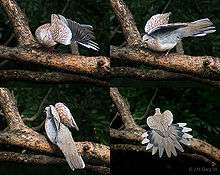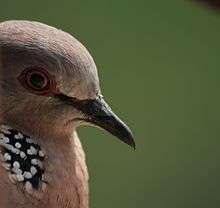Spotted dove
| Spotted dove | |
|---|---|
_Photograph_by_Shantanu_Kuveskar.jpg) | |
| S. chinensis suratensis (India) | |
| Scientific classification | |
| Kingdom: | Animalia |
| Phylum: | Chordata |
| Class: | Aves |
| Order: | Columbiformes |
| Family: | Columbidae |
| Genus: | Spilopelia |
| Species: | S. chinensis |
| Binomial name | |
| Spilopelia chinensis (Scopoli, 1768) | |
| Subspecies | |
| |
| Synonyms | |
| |
The spotted dove (Spilopelia chinensis) is a small and somewhat long-tailed pigeon which is a common resident breeding bird across its native range on the Indian Subcontinent and Southeast Asia. The species has been introduced into many parts of the world and feral populations have become established. This species was formerly included in the genus Streptopelia with other turtle-doves, but studies suggest that they differ from typical members of that genus. This dove is long tailed buff brown with a white-spotted black collar patch on the back and sides of the neck. The tail tips are white and the wing coverts have light buff spots. There are considerable plumage variations across populations within its wide range. The species is found in light forests and gardens as well as in urban areas. They fly from the ground with an explosive flutter and will sometimes glide down to a perch. It is sometimes also called the mountain dove, pearl-necked dove or lace-necked dove.
Description

The ground colour of this long and slim dove is rosy buff below shading grey on the head and belly. There is a half collar on the back and sides of the neck made of black feathers that bifurcate and have white spots at the two tips. The back has brown feathers with rufous spots in the Indian and subspecies. The lesser median coverts are grey brown. The Indian populations have these coverts with rosy spots at the tip divided by a widening dark grey streak along the shaft. The primary coverts are dark brown. The wing feathers are dark brow with grey edges. The centre of the abdomen and vent are white. The outer tail feathers are tipped in white and become visible when the bird takes off. Sexes are similar, but juveniles are duller than adults and do not acquire the neck spots until they are mature. The length ranges from 28 to 32 centimetres (11.2 to 12.8 inches).[2][3][4]
Abnormal plumages such as leucism can sometimes occur in the wild.[5]
Taxonomy
_on_a_Kapok_(Ceiba_pentandra)_tree_in_Kolkata_W_IMG_3476.jpg)
This species was formerly included in the genus Streptopelia but a 2001 study based on molecular sequence as well as vocalization indicated that this along with Streptopelia senegalensis stood out from the remaining taxa then included in Streptopelia.[6] This led subsequent authors to split them out into a separate genus. Carl Sundevall had erected the genus Stigmatopelia with the type senegalensis while also creating the genus Spilopelia (for chinensis, suratensis and tigrina, then treated as separated species) on the same page of his 1872 book.[7] Some authors used Stigmatopelia arguing that it has priority as it appears first on the page.[8] Schodde and Mason in their zoological catalogue of Australian birds however chose Spilopelia based on 24(b) of the ICZN Code which defers the decision to that of the first reviser.[9]

Several subspecies have been proposed for the plumage and size variation seen in different geographic populations. The nominate form is from China (Canton), which is also the origin of the introduced population in Hawaii. Subspecies formosa from Taiwan has been considered as doubtful and indistinguishable from the nominate population. The population in India suratensis (type locality Surat) and ceylonensis from Sri Lanka have fine rufous or buff spots on the back. There is a size reduction trend with specimens from southern India being smaller and ceylonensis may merely be a part of this cline. The lesser and median wing-coverts are also spotted at the tip in buff.[2] This spotting is lacking on populations further north and east of India such as tigrina which also differ greatly in vocalizations from the Indian forms. The population from Hainan Island is placed in hainana. Others like vacillans (=chinensis) and forresti (= tigrina) and edwardi (from Chabua = suratensis) have been considered invalid.[11][12]
Distribution and habitat


The spotted dove in its native range in Asia is found across a range of habitats including woodland, scrub, farmland and habitation. In India it tends to be found in the moister regions, with the laughing dove (Spilopelia senegalensis) being commoner in the drier areas. These doves are mostly found on the ground where they forage for seeds and grain or on low vegetation.[12]
The species has become established in many areas outside its native range. These areas include Hawaii, southern California,[13] Mauritius, Australia and New Zealand. In Australia, they were introduced in Melbourne in the 1860s and has since spread, often replacing native doves. They are now found in streets, parks, gardens, agricultural areas and tropical scrubs in diverse locations across Australia. The original populations appear to be chinensis and tigrina in varying proportions.[14]
Behaviour and ecology
_nest_W2_IMG_0519.jpg)
Spotted doves move around in pairs or small groups[15] as they forage on the ground for grass seeds, grains, fallen fruits and seeds of other plants.[16] They may however take insects occasionally and have been recorded feeding on winged termites.[17] The flight is quick with regular beats and an occasional sharp flick of the wings. A display flight involves taking off at a steep angle with a loud clapping of the wing and then slowly gliding down with the tail spread out.[12]
| Measurements | |||
|---|---|---|---|
| S. c. suratensis[12] | |||
| Culmen | 18–21 mm (0.7–0.8 in) | ||
| 19–21 mm (0.7–0.8 in) | |||
| Wing | 135–146 mm (5.3–5.7 in) | ||
| 132–143 mm (5.2–5.6 in) | |||
| Tail | 118–143 mm (4.6–5.6 in) | ||
| 117–133 mm (4.6–5.2 in) | |||
| Tarsus | 21–24 mm (0.8–0.9 in) | ||
| 20–24 mm (0.8–0.9 in) | |||
The breeding season is spread out in warm regions but tends to be in summer in the temperate ranges.[12] In Hawaii, they breed all year round, as do all three other introduced species of doves. Males coo, bow and make aerial displays in courtship.[18] In southern Australia, they breed mostly from September to January, and in the north in autumn.[19] They nest mainly in low vegetation, building a flimsy cup of twigs in which two whitish eggs are laid. Nests are sometimes placed on the ground or on buildings and other structures.[20][21] Both parents take part in building the nest, incubating and feeding the young. The eggs hatch after about 13 days and fledge after a fortnight.[12] More than one brood may be raised.[22]
The vocalizations of the spotted dove include cooing softly with a Krookruk-krukroo... kroo kroo kroo with the number of terminal kroos varying in the Indian population and absent in tigrina, chinensis and other populations to the east.[12]
The species has been extending its range in many parts of the world. Populations may sometimes rise and fall rapidly, within a span of about five years.[23] In the Philippines, the species may be outcompeting Streptopelia bitorquata.[24][25] Their habit of flushing into the air when disturbed makes them a hazard on airfields, often colliding with aircraft and sometimes causing damage.[26][27]
References
- ↑ BirdLife International (2015). "Spilopelia chinensis". IUCN Red List of Threatened Species. Version 2015.4. International Union for Conservation of Nature. Retrieved 3 June 2013.
- 1 2 Baker, ECS (1928). The Fauna of British India. Birds. Volume 5. London: Taylor and Francis. pp. 241–245.
- ↑ Baker, EC Stuart (1913). Indian pigeons and doves. London: Witherby & Co. pp. 203–213.
- ↑ Blanford, WT (1898). The Fauna of British India. Birds. Volume 4. London: Taylor and Francis. pp. 43–44.
- ↑ Hopwood, JC (1906). "Albinism in the Malay Spotted Dove (Turtur tigrinus) near Kindat, Upper Chindwin". J. Bombay Nat. Hist. Soc. 17 (1): 249.
- ↑ Johnson KP, De Kort S, Dinwoodey K, Mateman AC, Ten Cate C, Lessells CM, Clayton DH (2001). "A molecular phylogeny of the dove genera Streptopelia and Columba" (PDF). Auk. 118 (4): 874–887. doi:10.1642/0004-8038(2001)118[0874:AMPOTD]2.0.CO;2.
- ↑ Sundevall, Carl (1872). Methodi naturalis avium disponendarum tentamen. p. 100.
- ↑ Cheke, Anthony S (2005). "Naming segregates from the Columba-Streptopelia pigeons following DNA studies on phylogeny". Bulletin of the British Ornithologists' Club. 125 (4): 293–295.
- ↑ Schodde R; I J Mason (1997). Zoological Catalogue of Australia. Aves (Columbidae to Coraciidae). Volume 37.2. CSIRO publishing. p. 20. ISBN 978-0-643-06037-1.
- ↑ Whitman, CO (1919). Orthogenetic evolution in pigeons. The Carnegie Institution of Washington. p. 72.
- ↑ Peters, James Lee (1937). Check-list of birds of the world. Volume 3. Cambridge: Harvard University Press. pp. 97–98.
- 1 2 3 4 5 6 7 Handbook of the birds of India and Pakistan. Volume 3 (2nd ed.). New Delhi: Oxford University Press. 1981. pp. 151–155.
- ↑ Hardy JW (1973). "Feral exotic birds in southern California" (PDF). Wilson. 85 (4): 506–512.
- ↑ Frith HJ; JL McKean (1975). "Races of the introduced spotted turtledove, Streptopelia chinensis (Scopoli), in Australia". Australian Journal of Zoology. 23 (2): 295–306. doi:10.1071/ZO9750295.
- ↑ Sadedin SR, Elgar MA (1998). "The influence of flock size and geometry on the scanning behaviour of spotted turtle doves, Streptopelia chinensis". Australian Journal of Ecology. 23 (2): 177–180. doi:10.1111/j.1442-9993.1998.tb00715.x.
- ↑ Satheesan SM; Rao, Prakash; Datye, Hemant (1990). "Biometrics and food of some doves of the genus Streptopelia". J. Bombay Nat. Hist. Soc. 87 (3): 452–453.
- ↑ Sivakumaran N, Rahmani AR (2005). "Spotted Dove Streptopelia chinensis feeding on winged termites". Journal of the Bombay Natural History Society. 102 (1): 115.
- ↑ Ara, Jamal (1958). "Variation in the output of song of a Spotted Dove, Streptopelia chinensis (Scopoli)". J. Bombay Nat. Hist. Soc. 55 (1): 161–166.
- ↑ Frith HJ; JL McKern & LW Braithwaite (1976). "Sexual cycles and food of the doves Streptopelia chinensis and S. senegalensis in Australia". Emu. 76 (1): 15–24. doi:10.1071/MU9760015.
- ↑ Subramanya,S; Karthikeyan S; Prasad JN; Srinivasa TS; Arun B (1992). "An unusual nest-site of Spotted Dove Streptopelia chinensis (Scopoli)". J. Bombay Nat. Hist. Soc. 89 (2): 254.
- ↑ Allan, CW (1909). "Doves nesting on the ground". J. Bombay Nat. Hist. Soc. 19 (2): 523–524.
- ↑ Kumar SA (1981). "A close study of the Spotted Dove". Newsletter for Birdwatchers. 21 (7): 5–9.
- ↑ McClure HE (1991). "The collapse of a local population of Spotted Doves (Streptopelia chinensis) in southern California" (PDF). North American Bird Bander. 16 (2): 34–36.
- ↑ Peterson AT; Brooks, Thomas; Gamauf, Anita; Gonzalez, Juan Carlos T.; Mallari, Neil Aldrin D.; Dutson, Guy; Bush, Sarah E.; Clayton, Dale H.; Fernandez, Renato (2008). "The Avifauna of Mt. Kitanglad, Bukidnon Province, Mindanao, Philippines" (PDF). Fieldiana Zoology. 114: 1–43. doi:10.3158/0015-0754(2008)114[1:TAOMKB]2.0.CO;2.
- ↑ Waldbauer, GP & SM Waldbauer (1982). "First sight record of the Spotted Dove Streptopelia chinensis from Luzon and a summary of its range expansion in the Philippines". Bulletin of the British Ornithologists' Club. 102: 22–24.
- ↑ Linnell MA, Conover MR, Ohashi TJ (1996). "Analysis of Bird Strikes at a Tropical Airport". The Journal of Wildlife Management. 60 (4): 935–945. doi:10.2307/3802396. JSTOR 3802396.
- ↑ Yap CAM; NS Sodhi (2004). "Southeast Asian invasive birds: ecology, impact and management". Ornithological Science. 3: 57–67. doi:10.2326/osj.3.57.
External links
| Wikimedia Commons has media related to Spilopelia chinensis. |
| Wikispecies has information related to: Streptopelia chinensis |
- Photographs and other media on the Internet Bird Collection
- Pigeon taxonomy
- Spotted Dove Photos (Dark Mutation)
